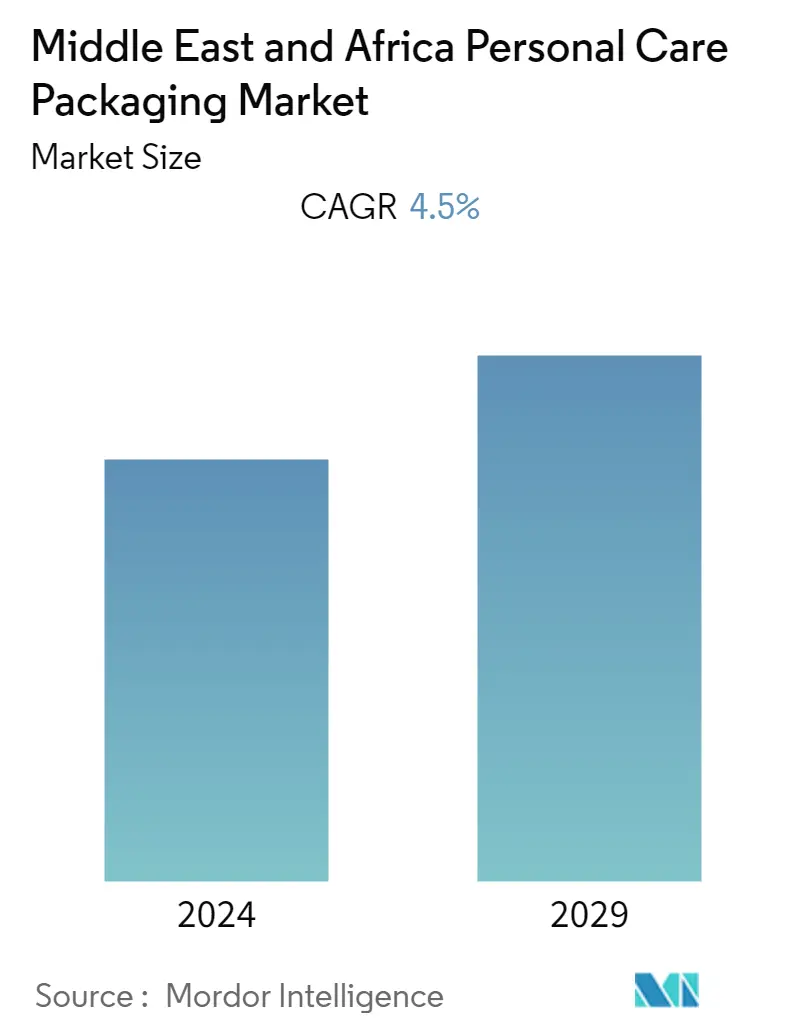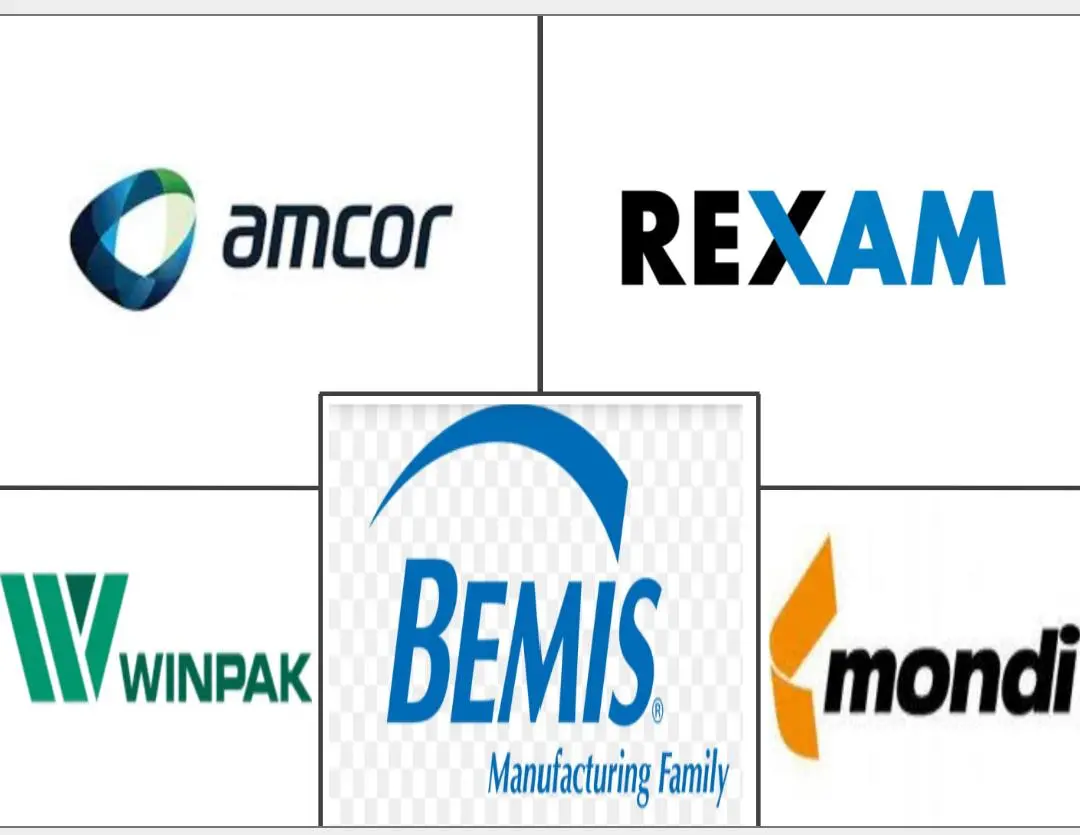Market Size of Middle East and Africa Personal Care Packaging Industry

| Study Period | 2019 - 2029 |
| Base Year For Estimation | 2023 |
| Forecast Data Period | 2024 - 2029 |
| Historical Data Period | 2019 - 2022 |
| CAGR | 4.50 % |
| Market Concentration | Medium |
Major Players
*Disclaimer: Major Players sorted in no particular order |
MEA Personal Care Packaging Market Analysis
The Middle East and Africa Personal Care Packaging Market is expecetd to register a CAGR of 4.5% during the forecast period (2021-2026). Factors like changing consumer lifestyle, increasing importance of packaging, rapid urbanization, and advancing packaging technology are aiding the growth of the personal care packaging market.
- An increased focus on natural skincare treatments, non-invasive beauty procedures, and the growing influence of beauty and lifestyle bloggers has contributed to steady growth in the UAE's personal care sector. Many experts opine the upswing in the UAE's personal care segment is fueled by the lifestyle that it is associated with. Medical specialists recommend proper skincare and personal care products to both genders, especially in the harsh climate of the UAE. Consumers in the UAE have a wide variety of choices in terms of cosmetics and fragrances. Hence, to capture the maximum market share and enhance their market presence, the cosmetics and fragrances companies are enhancing their packaging with a variety of materials, some of which are designed for sustainability. For instance, Hammamii, a UAE-made luxury spa brand, has adopted eco-friendly and recyclable packaging for its bags, bottles, and jars. Also, Camel Soap Factory, which is also UAE-based, has adopted environment-friendly packaging for its products, which are handmade from camel milk, olive oil, and beeswax.
- The cosmetics industry is gradually stepping up to combat the major problem of excess packaging, with multiple brands becoming more aware of the damage caused by the usage of single-use plastic. Eco-friendly beauty brands are now letting users refill their empty shampoo and perfume bottles-for instance, Le Labo's hand-blended fragrances and cult-favorite Santal 33. The product is bottled in a clear glass jar with pared-back labels; the product comes packaged in a recyclable cardboard box. The brand is also offering an in-store service that enables its users to refill their empty fragrance bottles for a maximum discount of up to 20%.
- Moreover, in Mar 2020, the Environment Agency of Abu Dhabi (EAD), which is the largest environmental regulator in the Middle East, announced that it aims to eliminate the usage of avoidable single-use plastic and non-plastic materials by 2021 through fostering a culture of recycling and re-use. Owing to the recent outbreak of coronavirus, effective handwashing and the usage of hand sanitizer in community settings are strongly recommended as the most important measures to avoid the transmission of COVID-19.
- Saudi Arabia is the largest market for cosmetic products in the Middle East and Africa, owing to the increasing spending powers and ability of women in the region. The country has depicted one of the highest rates of consumption of cosmetics in the MEA region and is also dominating the consumption of skin and hair care products. Consumers in Saudi Arabia are inclined toward spending large sums on their personal appearance, which is expected to supplement the growth of the cosmetic industry, hence, in turn, increasing the demand for personal care goods packaging in the country.
- According to a publication by Zawaya in July 2020, Saudi women are the biggest spenders for beauty and personal care products globally, who rack up USD 909 (3,350 UAE dirhams) in yearly bills. The increasing adoption of personal care products due to the increase in disposable income in the country is further expected to stimulate the value of the aesthetic value of these products. Also, the increasing penetration of social media and e-commerce websites in the country is increasing the demand for personal goods products, hence, stimulating the adoption of personal care product packaging.
MEA Personal Care Packaging Industry Segmentation
The Middle East and Africa Personal Care Packaging Market is Segmented by Material Type (Plastic, Glass, Metal, Paper), Packaging Type (Plastic Bottles and Containers, Glass Bottles and Containers, Metal Containers, Folding Cartons, Corrugated Boxes, Tube and Stick, Caps and Closures, Pump and Dispenser, Flexible Plastic Packaging), Product Type (Oral Care, Hair Care, Color Cosmetics, Skin Care, Man's Grooming, Deodorants).
Personal care products are often referred to as an assortment of items commonly found in the health and beauty departments of drug and department stores. Personal care packaging is extensively used for different products such as soaps, cosmetics, shampoos, oil, toiletries, and body creams etc.
| Material Type | |
| Plastic | |
| Glass | |
| Metal | |
| Paper |
| Packaging Type | |
| Plastic Bottles and Containers | |
| Glass Bottles and Containers | |
| Metal Containers | |
| Folding Cartons | |
| Corrugated Boxes | |
| Tube and Stick | |
| Caps and Closures | |
| Pump and Dispenser | |
| Flexible Plastic Packaging | |
| Other Packaging Types |
| Product Type | |
| Oral Care | |
| Haircare | |
| Color Cosmetics | |
| Skincare | |
| Men's Grooming | |
| Deodorants | |
| Other Products Types |
| By Country | |
| United Arab Emirates | |
| Saudi Arabia | |
| South Africa | |
| Rest of Middle East and Africa |
Middle East and Africa Personal Care Packaging Market Size Summary
The Middle East and Africa Personal Care Packaging Market is experiencing growth driven by factors such as evolving consumer lifestyles, the increasing significance of packaging, rapid urbanization, and advancements in packaging technology. The market is characterized by a strong focus on natural skincare and non-invasive beauty procedures, particularly in the UAE, where the personal care sector is influenced by lifestyle trends and the harsh climate. Companies in the region are enhancing their packaging with sustainable materials to capture market share, as seen with brands like Hammamii and Camel Soap Factory. The cosmetics industry is also addressing the challenge of excess packaging, with eco-friendly brands offering refillable options and initiatives to reduce single-use plastics, supported by regulatory efforts from entities like the Environment Agency of Abu Dhabi.
Saudi Arabia stands out as the largest market for cosmetic products in the region, driven by the high spending power of women and a strong inclination towards personal appearance. The increasing disposable income and the penetration of social media and e-commerce are further stimulating the demand for personal care products and their packaging. The market is competitive, with major players like Alpla, AMCOR Limited, and Mondi Group actively participating. Innovations in packaging, such as airless skincare solutions and advanced printing technologies, are enhancing the appeal and functionality of personal care products. The industry is also witnessing a shift towards recyclable and reusable packaging, with companies like Unilever and Berry Global Inc. leading efforts to reduce plastic waste.
Middle East and Africa Personal Care Packaging Market Size - Table of Contents
-
1. MARKET INSIGHTS
-
1.1 Market Overview
-
1.2 Industry Value Chain Analysis
-
1.3 Industry Attractiveness - Porter's Five Forces Analysis
-
1.3.1 Bargaining Power of Suppliers
-
1.3.2 Bargaining Power of Buyers
-
1.3.3 Threat of New Entrants
-
1.3.4 Threat of Substitute Products
-
1.3.5 Intensity of Competitive Rivalry
-
-
1.4 Impact of COVID-19 on the Personal Care Packaging Market
-
-
2. MARKET SEGMENTATION
-
2.1 Material Type
-
2.1.1 Plastic
-
2.1.2 Glass
-
2.1.3 Metal
-
2.1.4 Paper
-
-
2.2 Packaging Type
-
2.2.1 Plastic Bottles and Containers
-
2.2.2 Glass Bottles and Containers
-
2.2.3 Metal Containers
-
2.2.4 Folding Cartons
-
2.2.5 Corrugated Boxes
-
2.2.6 Tube and Stick
-
2.2.7 Caps and Closures
-
2.2.8 Pump and Dispenser
-
2.2.9 Flexible Plastic Packaging
-
2.2.10 Other Packaging Types
-
-
2.3 Product Type
-
2.3.1 Oral Care
-
2.3.2 Haircare
-
2.3.3 Color Cosmetics
-
2.3.4 Skincare
-
2.3.5 Men's Grooming
-
2.3.6 Deodorants
-
2.3.7 Other Products Types
-
-
2.4 By Country
-
2.4.1 United Arab Emirates
-
2.4.2 Saudi Arabia
-
2.4.3 South Africa
-
2.4.4 Rest of Middle East and Africa
-
-
Middle East and Africa Personal Care Packaging Market Size FAQs
What is the current Middle East and Africa Personal Care Packaging Market size?
The Middle East and Africa Personal Care Packaging Market is projected to register a CAGR of 4.5% during the forecast period (2024-2029)
Who are the key players in Middle East and Africa Personal Care Packaging Market?
Amcor, Bemis, Winpak, Rexam and Mondi Group are the major companies operating in the Middle East and Africa Personal Care Packaging Market.

